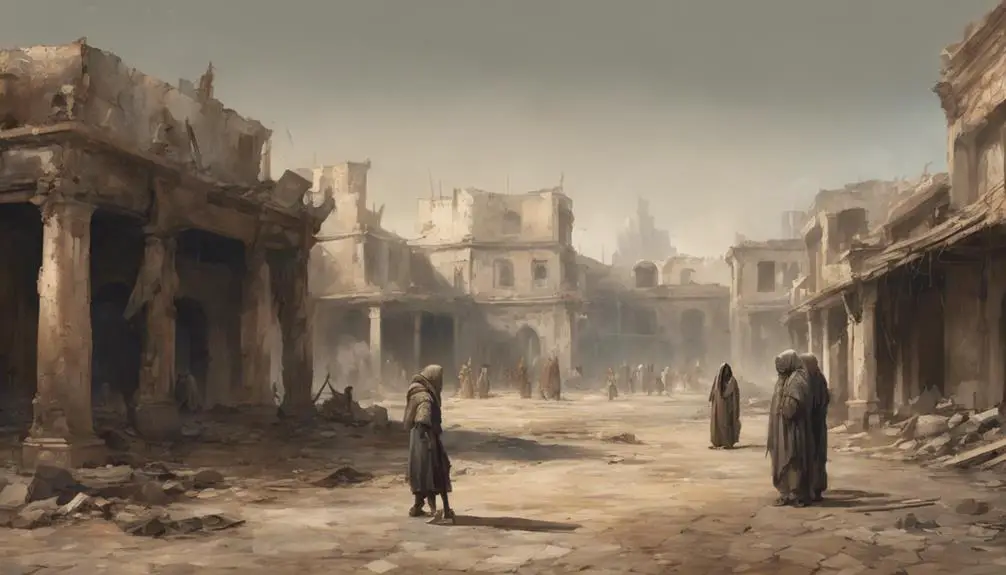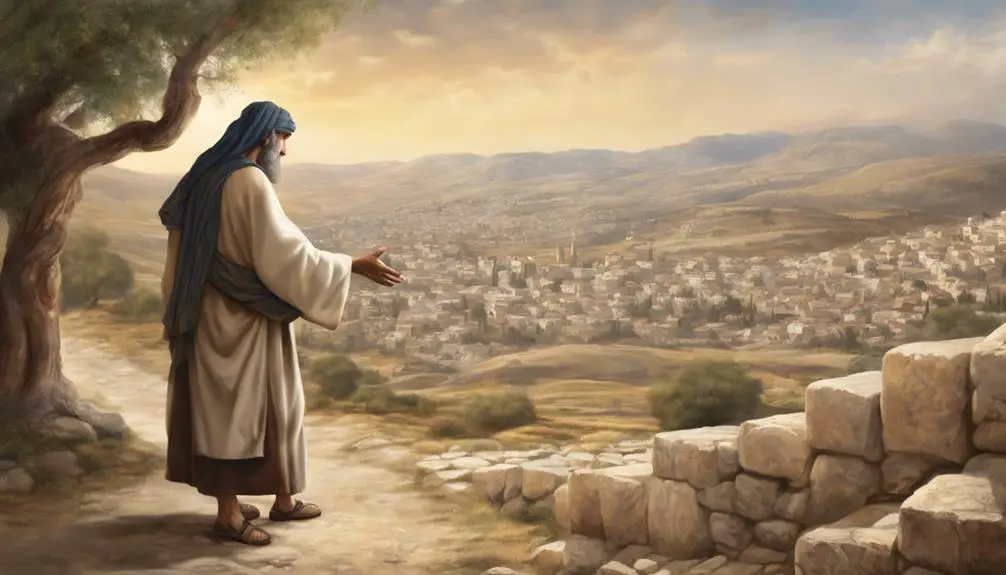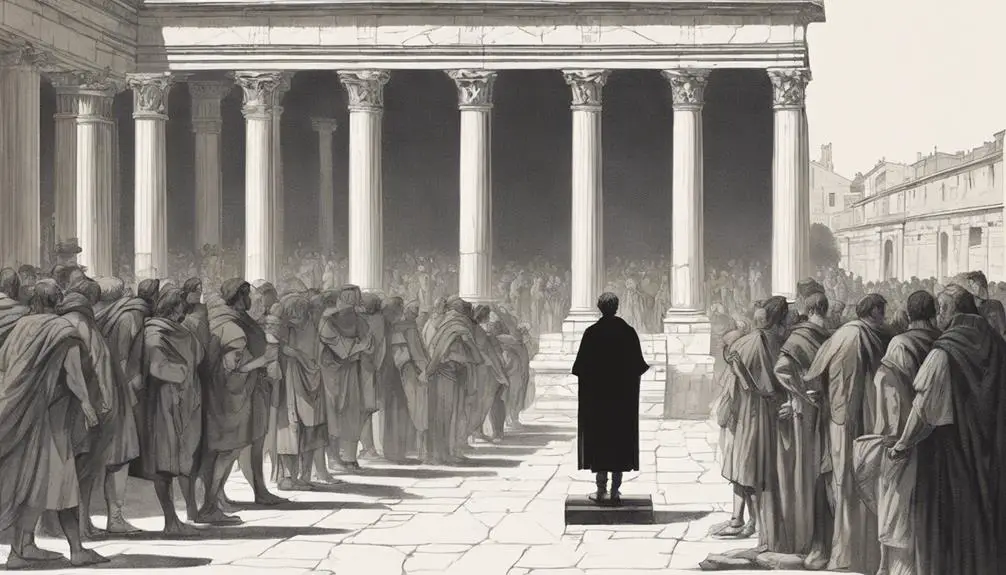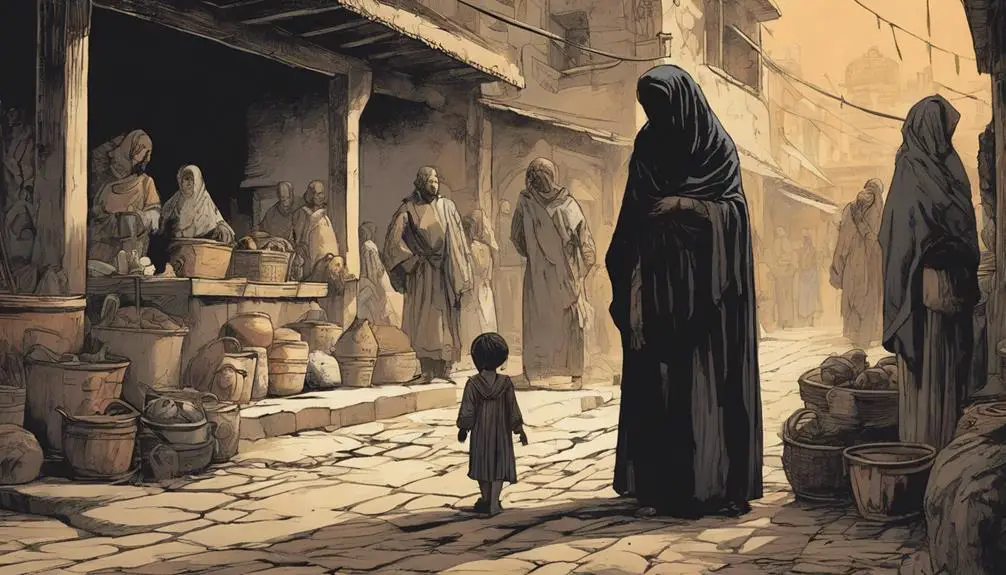Navigate the tales of biblical outcasts to uncover timeless lessons on compassion and inclusion, revealing their significance in today's society.

Outcast in the Bible
You might wonder if the Bible truly offers a compassionate view toward those deemed outcasts in society. Throughout its pages, figures like lepers, Samaritans, and even tax collectors find themselves on the fringes, often scorned and marginalized.
Yet, these narratives are not just ancient history; they challenge us to reflect on our perceptions of outcasts today. As you explore these stories, you'll discover a complex web of social dynamics, empathy, and, perhaps, a call to action that is as relevant now as it was then.
What might these age-old lessons teach us about compassion and inclusion in our contemporary world?
Key Takeaways
- Biblical narratives often highlight the restoration and inclusion of societal outcasts through divine compassion and miracles.
- Samaritans and tax collectors exemplify the complexities of social estrangement and the potential for reconciliation in biblical stories.
- The interaction with the Samaritan woman at the well underscores the theme of breaking down prejudices and extending inclusivity.
- Scriptures emphasize the moral and spiritual importance of caring for vulnerable groups like widows and orphans, reflecting a society's value on justice and compassion.
The Lepers: Society's Untouchables

In biblical times, leprosy epitomized the ultimate form of social ostracization, rendering its sufferers untouchables within their communities. This condition wasn't just a physical ailment; it carried a heavy social stigma that isolated individuals, cutting them off from their families, their communities, and their places of worship. Leprosy, therefore, wasn't only about the physical degradation but also about a profound loss of social identity and status.
The narratives of healing miracles in the Bible, particularly those involving lepers, aren't just accounts of physical healing but are deeply symbolic of restoring individuals back into the community. These stories underscore the power of compassion and the breaking down of barriers erected by societal prejudices. The act of healing leprosy in these texts does more than cure a disease; it challenges and overturns the existing social order, signaling a radical inclusivity that was revolutionary for its time.
Samaritans: Misunderstood Neighbors

The Samaritans, often depicted as adversaries in biblical narratives, actually represent a complex interplay of cultural and religious identities misunderstood by their neighboring populations. This misunderstanding stems from deep-seated cultural rifts but overlooks instances of Samaritan generosity that challenge prevailing stereotypes.
To understand the Samaritans' position better, consider the following points:
- Historical Context: The Samaritans emerged from a mix of Israelite survivors and foreign settlers post-Assyrian exile. This blend led to distinct religious practices and a separate identity from mainstream Judaism, fueling mutual mistrust.
- Cultural Rifts: Samaritans maintained a version of the Mosaic faith centered on Mount Gerizim, not Jerusalem. This deviation intensified their estrangement from Judean contemporaries, morphing into a broader cultural rift.
- Samaritan Generosity: Despite being marginalized, Samaritans are depicted in biblical parables demonstrating compassion and generosity, notably challenging prevailing prejudices against them.
- Misunderstood Neighbors: The narrative complexity surrounding the Samaritans highlights a broader theme of reconciliation and understanding, urging a reevaluation of outcast figures.
This multifaceted identity underscores the nuanced dynamics of ancient Near Eastern societies, where Samaritans weren't mere adversaries but participants in a shared, albeit contested, religious and cultural landscape.
The Woman at the Well

Building on the theme of Samaritan identity and interaction, a pivotal encounter unfolds in the biblical narrative between Jesus and a Samaritan woman at Jacob's well, challenging conventional perceptions of Samaritans and offering profound insights into cultural and religious barriers. This story, deeply embedded in the social fabric of the time, confronts and transcends the existing cultural barriers, illustrating a moment of profound theological and social revelation. Jesus' offer of 'living water' to the Samaritan woman not only subverts traditional expectations but also signifies a transformative moment of inclusivity and divine grace that crosses entrenched societal divides.
The dialogue between Jesus and the woman highlights a significant shift towards understanding and dismantling the prejudices that governed Samaritan-Jewish relations. It's a narrative that emphasizes the possibility of spiritual renewal and redemption beyond the constraints of ethnic and religious identity. The concept of 'living water' becomes a metaphor for the universality of Jesus' message, transcending cultural barriers and redefining the parameters of community and belonging. This encounter at the well serves as a critical juncture in the biblical text, where the boundaries of acceptance and grace are expanded, underscoring the inclusive nature of divine love and the breaking down of barriers that segregate and diminish human dignity.
Tax Collectors: Despised Collaborators

Tax collectors' role in biblical times positions them as one of the most universally despised figures, embodying the complex dynamics of power, betrayal, and societal disdain within their communities. This intense aversion stems from several critical factors:
- Financial Greed: They were seen as embodiments of financial greed, often accused of collecting more than the stipulated taxes, thereby enriching themselves at the expense of the common people.
- Roman Collaboration: Their work involved collaboration with the Roman Empire, the occupying force, which branded them as traitors in the eyes of their fellow Jews.
- Social Stigma: The social stigma attached to their profession made them pariahs in their own communities, isolating them from social and religious life.
- Moral Judgment: Their perceived dishonesty and unscrupulous behavior led to widespread moral judgment, further entrenching their outcast status.
This combination of financial exploitation, political betrayal, and social exclusion paints a vivid picture of why tax collectors were so deeply scorned. Their story is a testament to the complexities of societal dynamics in biblical times, illustrating how financial greed and collaboration with oppressive regimes can lead to profound social stigma and isolation.
Widows and Orphans: Vulnerable and Overlooked

In biblical times, widows and orphans often found themselves at the mercy of a society that overlooked their plight and failed to provide the necessary protection and support, rendering them among the most vulnerable groups. The scriptures, however, underscore the importance of divine protection and social obligations towards these marginalized individuals.
The Bible explicitly mandates the care for widows and orphans, emphasizing that such care isn't merely an act of charity but a divine commandment. This insistence on support reflects a broader theological principle: that the strength of a society is measured by its compassion and justice, particularly towards those unable to fend for themselves.
Moreover, the emphasis on divine protection for widows and orphans serves as a stern reminder of the moral and spiritual consequences of neglecting these duties. It suggests that the community's ethical integrity is closely tied to how it treats its most vulnerable members.
In essence, the treatment of widows and orphans in biblical narratives highlights the interplay between divine protection and social obligations. It challenges individuals and communities to reflect on their responsibilities towards the marginalized, urging a reevaluation of societal values and priorities in light of divine mandates.
Frequently Asked Questions
How Did Jesus' Interactions With Outcasts Challenge the Social Norms and Religious Practices of His Time?
Jesus' interactions, involving miraculous healings and parable teachings, starkly challenged the social norms and religious practices of his era. By engaging with those marginalized by society, he not only defied conventional religious boundaries but also redefined notions of purity and holiness.
His actions and stories emphasized compassion over ritual compliance, pushing his contemporaries to rethink their attitudes towards the marginalized, thus reshaping the social and religious landscape of his time.
In What Ways Did the Treatment of Outcasts in the Bible Reflect the Broader Societal Attitudes Towards Illness, Ethnicity, and Gender?
In analyzing historical texts, you'll find that societal attitudes towards illness, ethnicity, and gender often mirror broader cultural norms.
The treatment of individuals deemed 'outcasts' isn't isolated; it's deeply intertwined with concepts of ritual purity and social hierarchy.
This perspective offers a lens to understand how these attitudes weren't just personal biases but reflected in legal and religious practices, shaping interactions and reinforcing societal structures across various historical and cultural contexts.
Can You Find Examples of Outcasts in the Bible Who Played Pivotal Roles in the Narratives Despite Their Marginalized Status?
You'll find several examples of individuals who, despite being marginalized, emerged as unexpected heroes, showcasing remarkable rehabilitation journeys.
Mary Magdalene, initially outcast due to her occupation and alleged sins, becomes a pivotal figure in Christianity, witnessing Christ's resurrection.
Rahab, a prostitute, plays a crucial role in the fall of Jericho, aiding Israelite spies.
These stories highlight how overcoming societal barriers can lead to significant roles within their narratives.
How Do Modern Interpretations of Biblical Stories Involving Outcasts Influence Contemporary Attitudes Towards Social Justice and Inclusion?
Modern interpretations of biblical stories often highlight how cultural appropriation and interpretive ethics shape contemporary views on social justice and inclusion.
You'll find that these narratives, when analyzed through a modern lens, can either challenge or reinforce societal norms. They serve as a mirror reflecting our attitudes towards those marginalized, urging a reevaluation of our values and actions.
Through this lens, you're prompted to question and possibly redefine what inclusion truly means today.
What Parallels Can Be Drawn Between the Outcasts Mentioned in the Bible and Groups Considered Marginalized in Today's Society?
You can draw several parallels between historical outcasts and today's marginalized groups. By examining cultural parallels, you'll find that just as historical outcasts were often sidelined due to societal norms or laws, modern marginalized communities face similar challenges.
These parallels highlight how societal structures historically and currently operate to exclude certain groups. This analysis sheds light on the enduring nature of exclusion and the ongoing struggle for inclusion and social justice.
Conclusion
In conclusion, the Bible vividly illustrates the plight of societal outcasts, from lepers and Samaritans to tax collectors, widows, and orphans. Through these narratives, it's clear that these groups endured marginalization and prejudice, reflecting broader dynamics of exclusion and neglect.
Analyzing these stories reveals a profound critique of social structures that perpetuate inequality and a call for compassion towards those deemed as 'other.' Consequently, these biblical accounts offer timeless insights into the human condition and the imperative of social justice.



Sign up